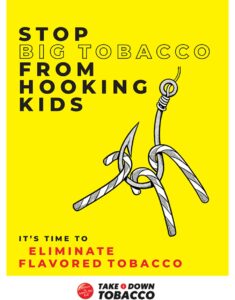(An internal update decided it wanted to save the an older version of this webpage.)
March 31st marks the Campaign for Tobacco-Free Kids’ Take Down Tobacco Day. The theme for 2023 revolves around the tobacco industry being jokers who gamble with people’s lives. It highlights marketing efforts from the tobacco industry that may be deceiving.


General Marketing1,2,3,4
- The tobacco industry spent $9.1 billion on marketing nationwide according to 2020 data. That’s $24.9 million a day.
- In Alaska, the industry spends $17.5 million yearly. That’s about $47,945 a day in the state.
- The industry targets specific populations. How so? Here’s some examples:
- Young people: candy and fruit flavored products, social media, influencers/celebrities, movies, music, in store promotions, and discounts
- Black Americans: more tobacco retailers are located in areas with larger Black populations; more tobacco advertisements in stores with mostly Black customers, price discounts, support of cultural events and activities (i.e. pop-up concerts featuring hip-hop artists in convenience stores)
- Low Income: more tobacco retailers exist in low-income communities, point-of-sale marketing (more retailers means more point of sale marketing exposure), discounts
- Military: tobacco was part of rations (historical), tobacco sold at commissaries and exchanges at discounted prices, sponsorship of military events, sent voice-recorded holiday cards on family’s behalf
Tobacco Industry and Public Health 5,6,7,8
Historical Context
- The tobacco industry worked with doctors to promote cigarettes
- The industry knew and accepted that cigarettes caused cancer by the late 1950s. (Research started suggesting so in the 1920s) Their response? Fund research studies to question other studies that said cigarettes caused cancer. This provided an opportunity for people to doubt independently funded scientific research.
- The industry formed the Tobacco Industry Research Committee to counter the research studies that linked smoking to certain diseases. It was eventually renamed as the Council for Tobacco Research.
- The industry also formed the Center for Indoor Air Research, which looked at research on indoor air related issues, and the Tobacco Institute, which acted as a PR and lobbying entity.
- In 1994, heads of major tobacco companies testified before Congress. They stated that the evidence that cigarettes caused disease was inconclusive, that cigarettes are not addictive, and they did not market to children. Less than a month later, industry documents were released and revealed that the heads of those companies lied.
Present Day
- In 2017, Phillip Morris (Marlboro) funded the Foundation for a Smoke-Free World. This foundation has entered scientific spaces and shaped public discourse. It has also published articles in established research journals by obscuring their role in funding and evading conflict of interest policies.
- The makers of JUUL sponsored a special issue of the American Journal of Health Behavior to highlight industry-funded research.
- Companies have spent millions on ads that show them as aligned with public health in national newspapers. Many of these publishers have policies prohibiting tobacco-sponsored content.
- They also have advertorials (ads in form of editorials) that range from “embracing science” to diversity, equity, and inclusion.
If you have an hour, check out The Truth Initiative’s webinar on the tobacco industry’s efforts to impact on scientific research.
Harm Reduction9,10,11
The tobacco industry has been framing e-cigarettes and other novel products as a means for harm reduction. Harm reduction is a great tool when it’s used appropriately. So what is harm reduction?
- Harm reduction: the principle of providing evidence-based, lower harm alternatives for those who do not quit harmful substances
- Example of harm reduction: during the height of the HIV/AIDS crisis, harm reduction was utilized to encourage widespread use of condoms by all sexually active individuals in non-monogamous relationships
- Harm reduction is NOT: pro- or anti- drug. It is not careless or indifferent about approaches to reducing harms of drug use. It is an intentional, evidence-based approach for reducing the risk of harm of drug use.
- Example for what harm reduction is not: selling methadone as a consumer product at convenience stores. (Methadone is used during medication assisted treatment to help people quit heroin or other opiates. It’s not needed by everyone). Harm reduction would be providing medically supervised context of drug use to limit the dangers of drug abuse and uptake by non-users in this context.
More detailed information can be found here. Here’s what we’re seeing in Alaska on tobacco use in Alaska:
- Cigarettes are the most commonly used products among adults.
- 15% using cigarettes alone
- 4% using cigarettes as well as other tobacco products
- That’s a total of 19% using alone or in combination of other products
- E-cigarettes are the least popular product among adults
- 3% use only e-cigarettes
- 3% use e-cigarettes and another tobacco product
- Total: 6% use e-cigarettes
- For youth, e-cigarettes are by far the most popular product
- 18% reported using e-cigarettes alone
- 8% reported using e-cigarettes and another tobacco product
- 26% reported using alone or with other products
- Math check: more youth are reporting e-cigarette use than adults. (Based on Census estimates for Alaska and these percentages: a little under 47,000 of those under 18 use e-cigarettes while a little over 33,000 of those over 18 use them).
- Cigarettes are the least popular product for youth
- 0.7% reported only using cigarettes
- 7% reported using cigarettes and another tobacco product
- Total: 8% use cigarettes alone or with other tobacco products
What the data is suggesting:
- Most adult tobacco users are using products that have known harmful effects over the short and long term.
- We don’t know all of the long-term impacts of e-cigarettes. But e-cigarettes share some of the same chemicals as cigarettes. Those chemicals are known to cause lung disease, cardiovascular issues, and cancer. The different chemicals? We’re waiting on research for the long-term impacts.
- Many youth are likely going from nothing to e-cigarette use. E-cigarettes have been found to have about 2,000 chemicals in them and have known short term negative consequences. How is it reducing harm if someone starts with no tobacco product and then picks up e-cigarettes?
- A higher percentage of youth tobacco e-cigarette users use multiple tobacco products than adults (8% vs. 3%). Meaning more are exposed to the health risks of other tobacco products on top of e-cigarette’s risk.
Take home questions, if harm reduction is the goal:
- Why are youth using e-cigarettes more often than adults?
- Why is there so less uptake from adults?
- It’s likely that many youth chose e-cigarettes as the first tobacco product they wanted to try and stuck with it. How is that harm reduction?
- If you want more information regarding concerns around e-cigarettes, check out our “E-Cigarettes for Parents: What You Should Know” post!
References
- The Toll of Tobacco in Alaska – Campaign for Tobacco-Free Kids (tobaccofreekids.org)
- Tobacco Industry Promotional Strategies Targeting American Indians/Alaska Natives and Exploiting Tribal Sovereignty – PMC (nih.gov)
- Unfair and Unjust Practices and Conditions Harm African American People and Drive Health Disparities | Smoking and Tobacco | CDC
- Big Tobacco Targets Military Because “Military is Less Educated, Part of ‘Wrong Crowd’ and Have Limited Job Prospects” – Marine Corps Community (usmc-mccs.org)
- zkmc0050 – More Doctors Smoke Camels Than Any Other Cigare… – Truth Tobacco Industry Documents (ucsf.edu)
- Commentary: How the tobacco industry wrote the ‘fake news’ playbook – SEATCA
- The Cigarette Controversy | Cancer Epidemiology, Biomarkers & Prevention | American Association for Cancer Research (aacrjournals.org)
- How the tobacco industry is trying to infiltrate public health – and what we can do about it (truthinitiative.org)
- Truth Initiative Statement on Harm Reduction
- Harm Reduction – What It Is and What It Is Not | Middle East Institute (mei.edu)
- Alaska Tobacco Prevention and Control Regional Profiles: Alaska Statewide 2022



